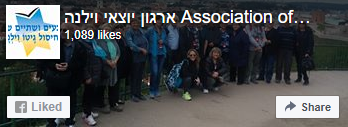The Jewish Community of Vilna
A Center of Torah Learning
Vilna had already become a preeminent center for rabbinical studies by the beginning of the 17th century. Among the scholars born in Vilna were Joshua Hoeschel Ben Joseph and Shabbetai Ha-Kohen, who served as dayyan of the community. The Rabbi of Vilna in the middle of the 17th century was Moses B. Isaac Judah Lima. Among the scholars of Vilna in the second half of the 17th century and the beginning of the 18th were R. Moses, called Kremer, his son-in-law Joseph, author of Rosh Yosef, Halakhic and Aggadic novellas; R. Baruch Kahana, known as Baruch Charif; the grammarian Azriel and his two sons Nisan and Elijah, and Zvi Hirsch Kaidanover. From the second half of the 18th century the personality and activities of Eliyahu ben Solomon Zalman, the Gaon of Vilna, who attracted numerous disciples, had a lasting impact on Vilna Jewry. The circle thus formed became the most stimulating religious and spiritual center there and had a profound influence on Judaism, especially in the domains of the Halakhah and Kabbalah.
Opposition to Chassidism
At the end of the 18th century, under the influence of the Gaon, Vilna became the center of the way of life and system of religious study followed by the Mitnaggedim and the focus of their struggle against Hasidism. In 1772 the Kahal disbanded the congregation formed in Vilna by the Hasidim and issued a ban or excommunication against them.
Bitter opposition to Hasidism continued throughout the lifetime of the Gaon. Nevertheless, groups of Hasidim still assembled clandestinely in Vilna and formed their own minyanim, and after 1790 the movement even found support among members of the Kahal. In 1798 the Vilna Kahal was prohibited from imposing fines or corporal punishment for religious offenses. When the Hasidic leader Shneor Zalman of Lyady was denounced to the authorities and imprisoned, 22 Hasidim from Vilna and its environs were also incarcerated, although afterward released. The Kahal elders and dayyanim were dismissed from office in 1799, and the Kahal accounts were examined. A new Kahal was then chosen from among the Hasidim, which controlled the Vilna community for over a year. Subsequently the two parties became reconciled and a new Kahal was elected with representatives of both parties. The Hasidim were permitted to form their own congregations.
The 19th Century
Vilna’s preeminence as the seat of Jewish learning continued in the 19th century. As an important center of Haskalah, it attracted many Hebrew writers. When the government commenced its policy of Russification of the Jews, it made Vilna a center of its activities. Max Lilienthal was sent there in 1842 to encourage the establishment of modern schools and in 1847 a government sponsored Rabbinical seminary was established.
The restriction limiting Jewish residence to certain streets in Vilna was abrogated under Alexander I in 1861. It was in this period that the first Jewish socialists in Russia began to be active in the official Rabbinical seminary, among them Aaron Samuel Liebermann and his associates. Anti-Jewish riots took place in 1881 when a band of military conscripts attacked Jewish shops. The Jewish butchers, who organized themselves to oppose the attackers, turned them over to the police. The 1897 census shows 63,831 Jewish inhabitants, 41.9% of the total population. The congested conditions and increasing unemployment led to large-scale emigration. Large numbers left for the United States and South Africa, and a few went to Palestine.
A Center of Jewish Political Activity
Vilna became an active meeting ground for Jewish socialists in the 1890s. A convention of Jewish social democrats was held in 1895, while in 1897 the Bund Labor Party held its founding convention and Vilna became the center of its activities. At the beginning of the 20th century Vilna became the center of the Zionist movement in Russia, and saw the rise of a flourishing Hebrew and Yiddish literature. One of the first societies of the Hibbat Zion movement was founded there; Chovevei Zion conventions were held in Vilna. Theodor Herzl, who visited Vilna in 1903, was given an enthusiastic popular reception. The central bureau of the Zionist organization in Russia functioned in Vilna between 1905 and 1911 and for some time the Po’alei Zion Party made Vilna its headquarters. The well-known Zionist leader Shmaryahu Levin was elected as deputy for Vilna to the Duma (Russian Parliament). Orthodox circles were organized under the leadership of R. Chayyim Ozer Grodzenski, and afterward were amalgamated with the Agudat Israel.
The First Half of the 20th Century
Vilna became a transit center and asylum for Jewish refugees from the vicinity during World War I. Under German occupation lack of food and discriminatory levies on the Jewish population made conditions increasingly difficult.
The situation was not improved after the war when the struggle between the Poles and Lithuanians for the possession of Vilna (1919-20) entailed frequent changes of government. In April 1919, 80 Jews were massacred by Polish troops.
The inter-war period from 1922 to 1939 was a time of fruitful and manifold social and cultural activities for Vilna Jewry. This period saw the establishment of a network of elementary and secondary schools in which Hebrew was either the language of instruction or the principal language, and of Hebrew and Yiddish teachers’ seminaries and trade schools. Vilna was a world center for Yiddish culture. The YIVO Research Institute for Yiddish language and culture was founded in Vilna in 1924.
From: Anu museum

